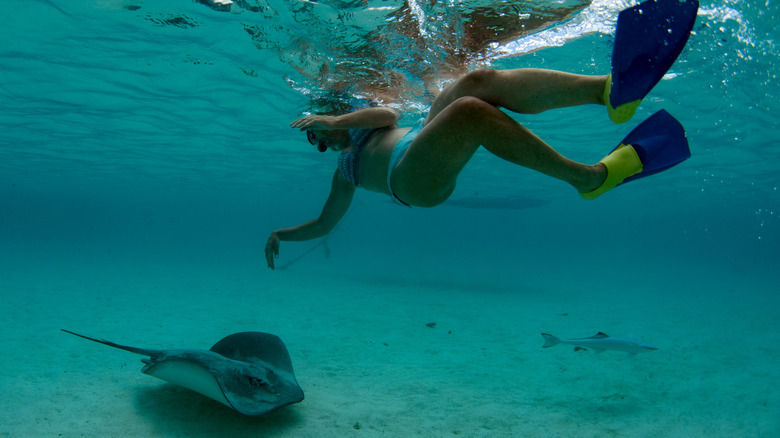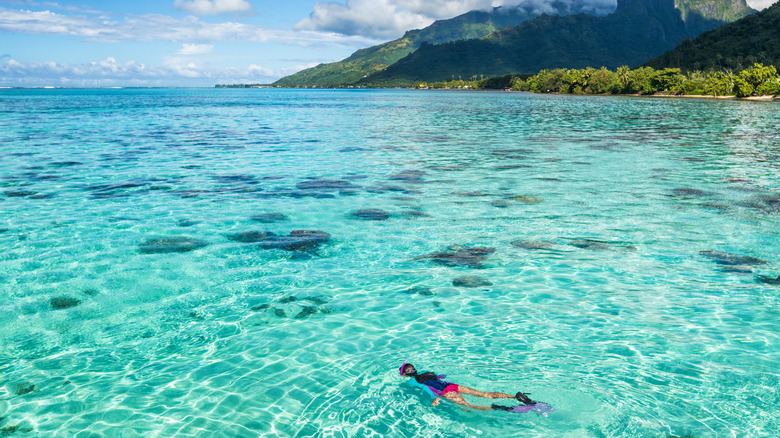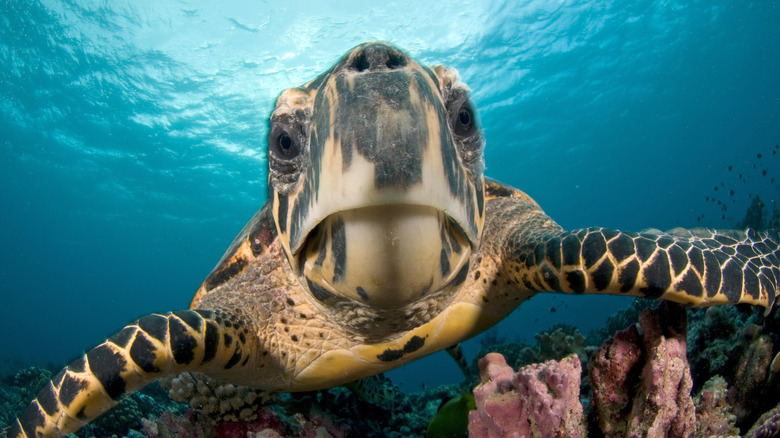Swim With Incredible Wildlife At This Stunning French Polynesian Island
The clear waters of Moorea (also spelled Mo'orea) are a must-visit for any wildlife lover. This stunning volcanic island makes up the Îles du Vent (the Windward Islands) of French Polynesia and is located only 12 miles away from the famous island of Tahiti. While the vistas from the craggy tops of Moorea are undoubtedly beautiful, the best way to enjoy this island is to get up close to the incredible oceanic creatures that swim around its lagoons and coastline. As Moorea is an atoll, the reefs surrounding it are teeming with sharks, rays, turtles, and a kaleidoscopic shoal of fish species you can snorkel alongside. Humpback whales and spinner dolphins can also be seen breaching in the waves beyond the reef.
To get to Moorea and enjoy this bucket list experience, take the ferry or fly from Tahiti. The flight takes 15 minutes and the ferry gets you there in 30 minutes. It costs around $12 for a one-way ferry ticket with fantastic views along the way. The flight is slightly quicker but it's much more expensive. According to Skyscanner, the cheapest possible return flight between Tahiti and Moorea is around $100, but there are multiple departures for both, operating seven days a week.
How to discover Moorea's marine wildlife
Moorea is perfect for both snorkeling and diving as there are many reefs to explore, close to shore and further out. The species that you may see around the island include green sea turtles, hawksbill turtles, manta rays, eagle rays, pilot whales, tuna, marlin, various sharks, different species of dolphins, squid, clownfish, eels, and stingrays. There is so much wildlife that marine biologists have specifically studied the flora and fauna of Moorea.
If you want to snorkel from the beach, Temae Beach and Ta'ahiamanu public beach in Opunohu Bay are both free to visit. If you want to snorkel in the lagoon at the Hilton Moorea Lagoon Resort it will cost around $90, including lunch. The Hotel Les Tipaniers rents kayaks to explore the area around Les Tipaniers beach which costs $10 per hour and you can snorkel there, too. There are also numerous boat trips that will take you to snorkel and dive spots that are further out from the beaches. One thing to try is night snorkeling which is a rare opportunity to see what the marine animals do after the sun goes down. If you go on a boat tour with a qualified operator then they will know exactly where to find the wildlife hotspots. They'll also be able to give you advice on which species to keep your distance from — For example, triggerfish can bite.
How to respect Moorea's marine wildlife
The marine ecosystem is a delicate one, so it's important to respect the corals and wildlife as damaging them can cause harm to both of you. Any harassment or unnatural feeding of ocean creatures can also change their behavior toward other tourists, or stop them from visiting the area altogether. The Lagoonarium area of the island is now closed, but the sharks there were used to being fed by people so responsible tour operators would avoid it.
While it may sound scary to get in the water with larger marine wildlife, black-tip reef sharks and lemon sharks are not considered dangerous. However, like any animal, they could show aggression if provoked. As the reef is already degraded — partly due to tourism — it is vital to avoid touching it as it can kill off the coral. Any injury from the reef also carries a high risk of infection due to the bacteria it carries. Aside from watching from a safe distance, the best way to interact with marine wildlife is by photographing it. Investing in an underwater camera or a waterproof kit can be an amazing way to capture the moment, especially in the unforgettably clear waters of Moorea.


